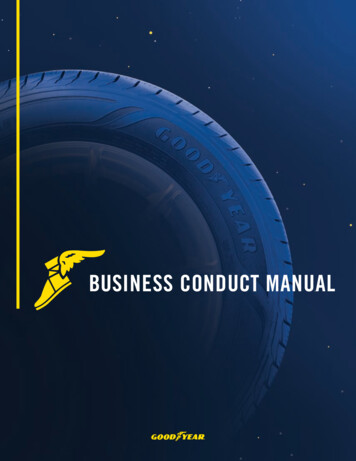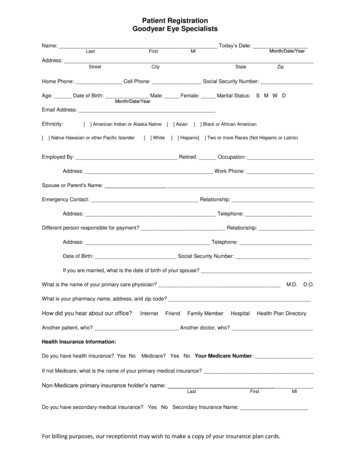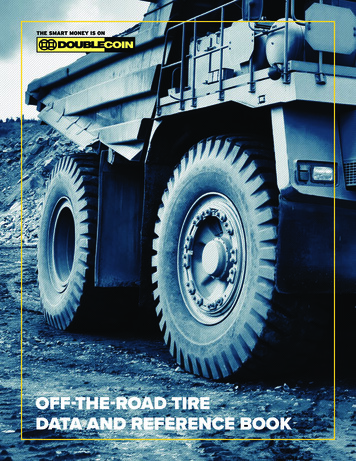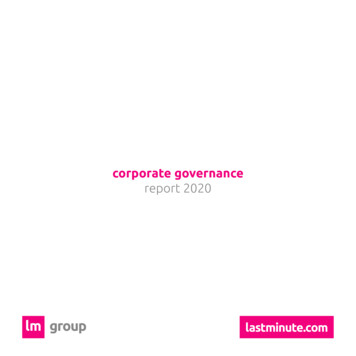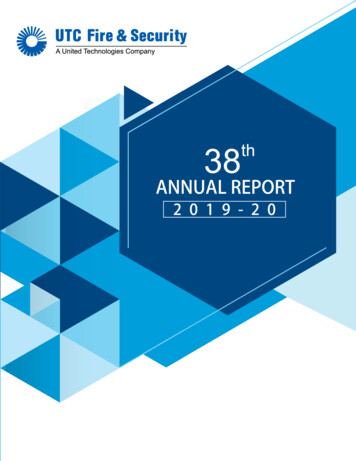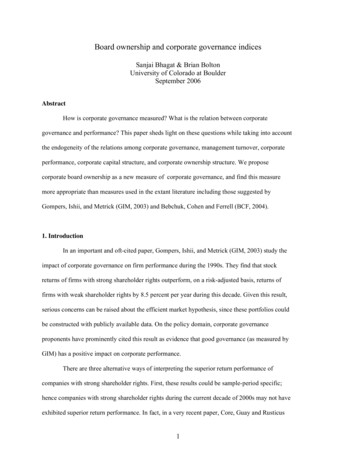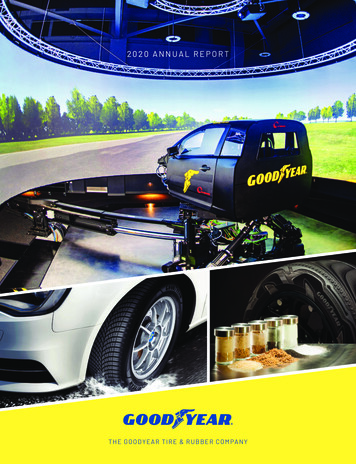
Transcription
2020 ANNUAL REPORTT H E G O O DYEA R T I R E & R U B B E R C O M PA N Y
Goodyear is one of the world’s leading tire companies, with one of the most recognizable brand names. It develops,manufactures, markets and distributes tires for most applications and manufactures and markets rubber-related chemicalsfor various uses. The company also has established itself as a leader in providing services, tools, analytics and products forevolving modes of transportation, including electric vehicles, autonomous vehicles and fleets of shared and connectedconsumer vehicles. Goodyear was the first major tire manufacturer to offer direct-to-consumer tire sales on-line and offersa proprietary service and maintenance platform for fleets of shared passenger vehicles. Within its global retail presence,Goodyear operates approximately 1,000 company-owned outlets around the world where it offers its products for sale toconsumer and commercial customers and provides repair and other services. It is one of the world’s largest operators ofcommercial truck service and tire retreading centers and offers a leading service and maintenance platform for commercialfleets. Goodyear is annually recognized as a top place to work and is guided by its corporate responsibility framework,Goodyear Better Future, which articulates the company’s commitment to sustainability. The company manufactures itsproducts in 46 facilities in 21 countries and has operations in most regions of the world. Its two Innovation Centers inAkron, Ohio, and Colmar-Berg, Luxembourg, strive to develop state-of-the-art products and services that set the technologyand performance standard for the industry.THE GOODYEAR TIRE & RUBBER COMPANY200 Innovation WayAkron, Ohio 44316-0001www.goodyear.comON THE COVERTop: In 2020, Goodyear became the first tire manufacturer to install a dynamic driving simulator. This system replicates real-world drivingconditions, allowing tires to be tested in a virtual environment before they are built, improving the speed and efficiency of the productdevelopment process.Lower left: The award-winning Goodyear Vector 4Seasons Gen-3 helped the company earn All-Season “Manufacturer of Year” honors fromGermany’s leading automotive magazine.Lower right: Among the components used in many Goodyear tires is rice husk ash silica, shown here in its stages of processing. The husksare stripped from rice (far left), burned to ash and converted to a silica substitute (far right). Rice husk ash silica is a bio-based replacementthat can deliver performance like traditional silica yet is more environmentally friendly and helps reduce waste going to landfill.In 2020, Goodyear returned to the 24 Hours of LeMans,marking the brand’s first appearance at the world’s mostprestigious endurance race since 2006. The event was asolid success, as two racing teams outfitted with Goodyeartires earned spots on the podium in their category. Inaddition, the Goodyear blimp made its first appearance inEurope in almost a decade and provided aerial coveragefor more than 30 television networks around the world.
FINANCIAL OVERVIEWYEAR ENDED DEC. 31YEAR ENDED DEC. 3120202019 12,321 1,984 (1,254) (5.35) 14,745 3,143 (311) (1.33)234234233233(in millions, except per share and associates)Net SalesGross ProfitGoodyear Net Income (Loss)– Per Diluted ShareWeighted Average Shares Outstanding – Basic– DilutedSegment Operating Income (Loss)Segment Operating MarginGross MarginReturn on SalesCapital ExpendituresResearch and Development ExpendituresTire Units Sold (14)(0.1%)16.1%(10.2%) 647 390126.0 Total AssetsTotal Debt*Goodyear Shareholders’ EquityTotal Shareholders’ EquityDebt to Debt and EquityCommon Stock Dividends Paid 16,506 5,990 3,078 3,25964.8% 37 17,185 5,663 4,351 4,54555.5% 148Number of AssociatesPrice Range of Common Stock: – High– Low 62,00015.694.09 9456.4%21.3%(2.1%)770430155.363,00022.1710.74* Total debt includes Notes payable and overdrafts, Long term debt and finance leases due within one year, and Long term debt and finance leases.CONTENTSTo Our ShareholdersManagement’s Discussion and Analysis of Financial Condition andResults of OperationsForward-Looking InformationQuantitative and Qualitative Disclosures about Market RiskConsolidated Financial StatementsNotes to Consolidated Financial StatementsManagement’s Report on Internal Control Over Financial ReportingReport of Independent Registered Public Accounting FirmSupplementary Data (Unaudited)Selected Financial DataGeneral Information Regarding Our SegmentsPerformance GraphDirectors and OfficersFacilitiesShareholder InformationThis Annual Report contains a number of forward-looking statements. For more information, please see page 30.263031334089909395969798991001
TO OUR SHAREHOLDERSINTRODUCTIONThroughout our 122-year history, The Goodyear Tire &Rubber Company has faced daunting challenges. Since wewere founded, we have continued operations through twoWorld Wars, economic depression and cycles of recessionand cultural change around the globe. In every situation,we adjusted to the dynamic conditions and kept movingforward.In 2020, the global coronavirus pandemic caused adisruption unlike anything we’ve experienced in our history.But, as we have done in every other instance, Goodyearresponded to the conditions, changed how we worked andremained vital to moving the world forward. I’m pleased tosay that despite the challenges, our business continuedto make significant progress in critical areas.Richard J. KramerGoodyear Chairman, Chief Executive Officer & PresidentGlobally, we enhanced our original equipment pipeline,winning fitments representing more than nine million unitsof future volume, with many on electric vehicles. We drovegreater efficiencies across our manufacturing footprint andlaunched new tire management tools and fuel-efficientproducts that allowed us to continue winning withcommercial fleets. We strengthened our position in theemerging new mobility ecosystem with new product andservice offerings. And we reinforced and increased ourcommitment to sustainability.The top priority of our response to COVID-19 is the healthand wellbeing of our associates. Like the rest of the world,we saw the first signs of outbreak in China and respondedby suspending manufacturing at our facility in Pulandian inFebruary. We followed in early March with a safe and orderlyshutdown of nearly all our global tire manufacturing plants,something never done before in Goodyear’s history.OUR RESPONSE TO COVID-192
Immediately, we took decisive actions to safeguard ourbusiness to mitigate the effects of the pandemic. Wecontinued to serve customers from our inventory of tires,minimizing the disruption to our business. Goodyear’snetwork of aligned dealers and distributors was essential tothe worldwide pandemic response, helping keep firstresponders – including police, firefighters and emergencymedical providers – commercial fleets and economiesmoving forward. Though our customers faced challengesto their own businesses, their response was pivotal tosustaining the transportation of critical goods and services.It is important to acknowledge that our associates continuedto deliver outstanding performance while in many casesbalancing shifting responsibilities and increased challengesin their personal lives. We implemented work-from-homeprotocols for office locations, as Goodyear associates foundnew ways to work to stay close to consumers, customersand each other.Though the pandemic had immediate and severe effects oneach of our businesses, we did not allow it to derail ourmomentum. Among the factors that contributed to ourperformance in the face of unprecedented challenges wereseveral initiatives already in place that gave Goodyear anadvantage as consumer behavior continued to evolve duringthe pandemic.For example, in the Americas, our well-establishede-commerce platform allowed us to serve consumers ason-line purchases increased. Also, we expanded the reachof mobile installation in the U.S., giving us an advantagewhile stay-at-home directives were in place.By taking advantage of such industry-leading assets andacting with agility and urgency, Goodyear made it easier forconsumers and customers during such a disruptive year.Even through the difficult environment, we positioned thecompany for strong recovery.By using digital tools and increasing communication, westayed attuned to the needs of customers to limit thechance of service interruption. When stay-at-homemandates affected both consumers’ buying options andtraditional sales and service operations, Goodyear’s retailand commercial fleet service locations introduced“zero-contact” options to assure safety.We adjusted our goals to focus on maintaining a leadingposition in the market, reducing cost and strengtheningcash flow. We executed cost savings programs whilecontinuing to support our new product development andincreased service offerings. As a result, we increased ourshare of market in several important segments, reducedcosts with minimal effect on our operations and exceededour expectations on cash flow.3
CONTINUING OUR MOMENTUMOver the past few years, we have focused on the evolutionof consumer preferences and behavior as a world of newmobility takes shape. Driven by technology, the changes inthe transportation environment had reached an inflectionpoint prior to the onset of the global pandemic. Last year,we believe that COVID-19 didn’t slow the adoption of thesechanges; it accelerated their adoption. Likewise, weincreased our commitment to actively shaping new mobilitywhile investing in our core businesses. Products – The best lineup of tires for both originalequipment and replacement continued to grow,particularly for electric vehicles (EVs). New consumer EVfitments include the Porsche Taycan, the VolkswagenID.3 and the GMC Hummer EV. In addition, we aresupplying original equipment (OE) tires for LordstownMotors, a new American manufacturer of an all-electriclight truck. Our portfolio of products continued to earnthird-party recognition in Europe, Middle East and Africa.For example, a leading German automotive magazinehonored Goodyear as manufacturer of the year forall-season tires for our Vector 4Seasons Gen-3all-season tire. We also earned the OE fitment on theFord Transit in Europe, an important vehicle for theincreasing need for last-mile deliveries. Our productand brand strength continued to grow in China, led bythe success of the Eagle F1 SuperSport. Though theglobal aviation business has yet to recover from thepandemic, we earned the China Eastern Airlines Boeing777 business and captured a new customer withHainan Airlines. Services – Our commercial truck service centerscontinued to provide best-in-class products andservice for fleets. In the Americas, we expanded oure-commerce platform in our commercial tire business,giving fleets of all sizes access to our products, leadingservice network and complete tire management solutions. Also, our value proposition helped us win valuablenew customers in 2020, earning the Ryder, Dart,Pepsi MidAmerica and Albertson’s Grocery businesses,among others.We also made strides in our commercial business inEurope, Middle East and Africa, where we enhancedour Total Mobility Solutions offering with new tools andservices. The pandemic did not derail our efforts to drivealigned distribution for our consumer business inEurope, where we continued to execute our plans withfull-service distributors. We increased our presence inemerging markets with new aligned distributors.Also, we are making progress on aligned distribution inAsia Pacific, especially China, which is allowing us tobetter capture the value of our brand. Technology – In 2020, Goodyear continued to expandour technology capabilities, developing more predictiveanalytics and digital solution platforms. We madeimportant strides with our intelligent tire, which isequipped with sensors to provide real-time analyticsfor enhancing the safety, performance and handling ofnew vehicles, including future autonomous vehicles. Inaddition, Goodyear became the first tire manufacturerto have its own dynamic driving simulator. The simulatorcreates an immersive experience that replicates drivinga tire at its limits, enabling us to increase the speed oftire development and strengthen collaboration withoriginal equipment manufacturers. Partnerships – As part of Goodyear’s commitment tohelping shape the future of new mobility, we announcedthe formation of Goodyear Ventures. This venture capitalfund of 100 million over 10 years is targeted fornew investments in future mobility solutions. The firstinvestment launched AndGo, a fully integrated vehicleservicing platform for passenger fleets. We also investedin Envoy Technologies, a provider of shared electricvehicles, and we expanded our partnership with Borrow,a California-based electric-car subscription company.On the commercial side, we joined with TuSimple, aglobal autonomous trucking technology company, toprovide tires and tire management solutions.4
Sustainability – We continued developing new solutionsthat not only enhance the performance of our productsbut do so with alternative materials and processes thatreduce impact on the environment. Goodyear remainsthe only tire manufacturer to feature soybean oil, insteadof petroleum oil, in tread compounds. We have increasedour use of soybean oil in many of our best-sellingtires and are on our way to an established goal ofreplacing all petroleum-derived oils in our tires by 2040.We’re also using rice husk ash silica to help deliverperformance equal to or better than traditional sandbased silica in tires, with less environmental impactand waste to landfills.REFLECTIONSThroughout our history, Goodyear has faced almost everykind of challenge. Each time we’ve been confronted withsomething different or unanticipated, we’ve assessed oursituation, made a plan and responded as quickly andthoroughly as possible. Such was the case with thepandemic in 2020. Though the global social and economicdisruption was unprecedented, we reacted as we alwayshave. We stayed agile, acted with urgency and neverbecame complacent. We took care of our customers andkept moving forward. And when the market started to showsigns of recovery as the year wound down, we grew ourshare and outperformed the industry in a variety ofmeasures.Over the past year, I’ve talked to our associates about the“Goodyear spirit,” an attitude of finding solutions when noneseem apparent, of turning challenges into opportunitiesand of staying positive when surrounded by adversity. Ourassociates embodied this spirit every day and kept ourbusiness moving forward. In the course of delivering greatproducts and services, they did something even more:they kept the world moving.Unfortunately, COVID-19 infection rates continue to bevolatile around the world and the long-term effects are stillunknown. However, our people are the source of confidencethat Goodyear will continue to be a great partner, supplierand innovator.Speaking for all of us at Goodyear, thank you for yourongoing support and trust.Respectfully submitted,Richard J. KramerChairman, Chief Executive Officer & PresidentWhat we’ve accomplished, from where we were, is nothingshort of phenomenal. I have never been prouder of ourremarkable associates. While there have been times ofanxiety and uncertainty, those days are easily outnumberedby moments of inspiration, ingenuity and grit.5
MANAGEMENT’S DISCUSSION AND ANALYSIS OF FINANCIAL CONDITION AND RESULTS OFOPERATIONS.OVERVIEWThe Goodyear Tire & Rubber Company is one of the world’s leading manufacturers of tires, with one of the most recognizablebrand names in the world and operations in most regions of the world. We have a broad global footprint with 46 manufacturingfacilities in 21 countries, including the United States. We operate our business through three operating segments representingour regional tire businesses: Americas; Europe, Middle East and Africa; and Asia Pacific.This management's discussion and analysis provides comparisons of material changes in the consolidated financial statementsfor the years ended December 31, 2020 and 2019. For a comparison of the years ended December 31, 2019 and 2018, refer toManagement's Discussion and Analysis of Financial Condition and Results of Operations included in our annual report onForm 10-K for the year ended December 31, 2019.Results of OperationsOur results for 2020 were highly influenced by the severe economic disruption caused by the ongoing COVID-19 pandemic.However, based on recent favorable recovery trends, particularly in the U.S., Europe and China, the negative impacts of thepandemic on tire industry demand, auto production, miles driven and our tire volume have moderated and are expected tocontinue to improve. The tire industry has been negatively impacted by this evolving situation, particularly earlier in the year,which was characterized by a sudden and sharp decline in replacement tire demand and original equipment (“OE”)manufacturers suspending or severely limiting automobile production globally. This environment, which persisted throughoutmuch of 2020, aggravated already challenging industry conditions in many of our key markets, including foreign currencyheadwinds due to a strong U.S. dollar, lower OE industry volume, softening demand in Europe, weak market conditions inChina and economic volatility in Latin America, that were present throughout 2019.We continue to take actions in response to COVID-19 to protect the health and wellbeing of our associates, customers andcommunities, which remain our top priority, to mitigate the near- and long-term financial impacts on our operating results, andto ensure adequate liquidity and capital resources are available to maintain our operations until the auto industry andreplacement tire demand fully recovers.Actions taken throughout 2020 included: In March 2020, we announced the suspension of production in Europe and the Americas. These temporary measureswere implemented in a way that allowed us to safely and promptly resume production as public health and marketconditions improved. We completed a phased restart of most of our manufacturing facilities during the second quarterof 2020, without any significant subsequent COVID-19 related disruptions. During parts of the first half of 2020, production was also temporarily suspended or significantly limited in severallocations in Asia Pacific, most notably at our Pulandian, China manufacturing facility. Our Pulandian facility beganoperating with all of its workforce by the end of the first quarter. Throughout the third quarter of 2020, we continued to ramp up tire production across our manufacturing footprint andmost of our factories returned to full capacity by the end of the third quarter and remained at full capacity during thefourth quarter. Our decisions to change production levels in the future will be based on an evaluation of marketdemand signals, inventory and supply levels, as well as our ability to continue to safeguard the health of our associates. As our business is deemed essential in the U.S. and most other parts of the world, in order to maintain customerservice, warehouses, commercial truck service centers and retail operations remained largely operational throughoutthe year on a reduced staffing schedule, when necessary, and with strong social distancing practices in place. Wecontinue to closely monitor local conditions surrounding these operations, as well as inventory and supply levels, tocontinue delivery of our products. We are following guidance from the Centers for Disease Control and Prevention and have introduced a number ofpreventative measures at our facilities that are open, including limiting visitor access and business travel, remoteworking and social distancing practices, and increased frequency of disinfection. On April 2, 2020, we announced second quarter actions to reduce our payroll costs through a combination of furloughs,temporary salary reductions and salary deferrals covering over 9,000 of our corporate and business unit associates,including substantial salary reductions and deferrals for our CEO, officers and directors. These and other similar6
actions reduced our expenses by approximately 65 million during the second quarter of 2020, while taking advantageof governmental income replacement programs to ensure our associates were supported. On April 9, 2020, we amended and restated our 2.0 billion first lien revolving credit facility, extending the maturitydate from April 2021 to April 2025. The refinancing includes favorable adjustments to the calculation of the facility’sborrowing base, which improved our availability under the facility by approximately 230 million at December 31,2020. In May 2020, we further strengthened our liquidity position by issuing 800 million of 9.5% senior notes due2025, a portion of the proceeds of which were used to repay our 282 million 8.75% senior notes at maturity in August2020. For further discussion related to these important sources of liquidity, refer to “Liquidity and Capital Resources.” On April 16, 2020, we announced that we suspended the quarterly dividend on our common stock. Previously, thesedividends totaled approximately 37 million each quarter. We are leveraging governmental relief efforts when available to defer payroll and other tax payments, which benefitedfull-year cash flows by approximately 60 million in the U.S. alone. In addition, we benefited from a provision in theCoronavirus Aid, Relief, and Economic Security Act that provided for a 50 percent refundable payroll tax credit onwages, including continuing health benefits, paid to U.S. employees retained but not working due to the COVID-19pandemic. As a result, during 2020, we recorded a benefit of 12 million as an offset to payroll tax expense. We have taken, and will continue to take, as necessary, other actions to reduce costs and preserve cash in order tosuccessfully navigate the current economic environment, including limiting capital expenditures to 647 million for2020 and reducing discretionary spending, including other selling, administrative and general expenses (“SAG”),which, in total, decreased by 131 million in 2020.Additionally, on April 17, 2020, we reached a tentative bargaining agreement, which was ratified on May 1, 2020, andsubsequently permanently closed our Gadsden, Alabama manufacturing facility (“Gadsden”) as part of our continuing strategyto strengthen the competitiveness of our manufacturing footprint by curtailing production of tires for declining, less profitablesegments of the tire market. We estimate the total pre-tax charges associated with this plan to be 280 million to 295 million,of which 170 million to 180 million are expected to be cash charges. We recorded 189 million of these charges and madecash payments of 46 million during 2020. The remaining charges will be recorded and the remaining cash payments will bemade primarily in 2021 and 2022. We expect the combined impact of this plan and the previously announced rationalizationactions related to Gadsden will result in approximately 130 million in annual savings in 2021 when compared to 2019.Our results for 2020 reflect an 18.9% decrease in tire unit shipments compared to 2019, as industry demand was significantlyaffected, particularly in the second quarter of 2020, by the actions governments, businesses and consumers took to slow thespread of COVID-19. More recently, the macroeconomic impacts of the pandemic have moderated and are expected tocontinue to improve. Our tire unit shipments were down 17.6%, 45.5%, 9.1% and 4.9% in the first, second, third and fourthquarters of 2020, respectively, compared to 2019. Our results for 2020 include a 394 million unfavorable impact due to higherconversion costs, primarily as a result of lower factory utilization and other period costs directly related to the suspension ofproduction and subsequent ramp up at our manufacturing facilities, partially offset by cost savings of 370 million, includingraw material cost saving measures of 61 million. Cost savings for 2020 include approximately 140 million of costs eliminatedin response to the COVID-19 pandemic, including through furloughs and government support programs, most of which areexpected to return in 2021.Net sales were 12,321 million in 2020, compared to 14,745 million in 2019. Net sales decreased in 2020 primarily due tolower global tire volume, lower sales in other tire-related businesses, primarily due to lower aviation sales globally and adecrease in third-party sales of chemical products in Americas, and unfavorable foreign currency translation, primarily inAmericas and EMEA. These decreases were partially offset by improvements in price and product mix, primarily in EMEAand Americas.Goodyear net loss in 2020 was 1,254 million, or 5.35 per diluted share, compared to Goodyear net loss of 311 million, or 1.33 per diluted share, in 2019. The increase in Goodyear net loss in 2020 was primarily driven by lower segment operatingincome and non-cash goodwill and other asset impairment charges, partially offset by lower income tax expense.Our total segment operating loss for 2020 was 14 million, compared to income of 945 million in 2019. The 959 milliondecrease was primarily due to lower global tire volume of 571 million, higher conversion costs of 394 million, primarily inAmericas and EMEA, and lower income from other tire-related businesses of 158 million, driven by lower aviation salesglobally and lower third-party chemical sales in Americas. These decreases were partially offset by lower SAG of 100 million,primarily due to lower wages and benefits and lower advertising expense reflecting actions taken as a result of the COVID-19pandemic, lower raw material costs of 63 million, primarily in EMEA and Asia Pacific, and improvements in price and product7
mix of 38 million, primarily in EMEA and Americas, partially offset by unfavorable price and product mix in Asia Pacific.Refer to "Results of Operations — Segment Information” for additional information.LiquidityAt December 31, 2020, we had 1,539 million in cash and cash equivalents as well as 3,881 million of unused availabilityunder our various credit agreements, compared to 908 million and 3,554 million, respectively, at December 31, 2019. Cashand cash equivalents increased by 631 million from December 31, 2019 primarily due to cash flows from operating activitiesof 1,115 million and net borrowings of 250 million, partially offset by capital expenditures of 647 million and first quarterdividends paid of 37 million. Cash flows from operating activities reflect cash provided by working capital of 871 million.Cash flows from operating activities also reflect our net loss for the year of 1,250 million, which includes non-cash chargesfor depreciation and amortization of 859 million and goodwill and other asset impairments of 330 million, as well as currentyear changes in Balance Sheet Accounts for Other Assets and Liabilities and Compensation and Benefits totaling 290 million.Refer to "Liquidity and Capital Resources" for additional information.OutlookThe COVID-19 pandemic caused the temporary closure of many businesses throughout the world during 2020, which limitedglobal business activity, particularly earlier in the year. Most of our manufacturing facilities around the world suspended orsignificantly limited production at times during the first half of 2020 in response to the pandemic. We completed a phasedrestart of most of our manufacturing facilities during the second quarter of 2020, returned to full capacity by the end of thethird quarter, and remained at full capacity during the fourth quarter.During the second half of 2020, tire demand in our major markets recovered faster than we anticipated. The stronger thanplanned volume exceeded our production. We expect to reinvest 450 million to 500 million in working capital during 2021given the decrease in our inventory levels during 2020.While markets have recovered considerably, we continue to face a high level of uncertainty as several governments around theglobe have recently implemented, or are considering implementing, measures to slow the pandemic that have the potential toreduce economic activity and mobility. We expect volume in the first quarter of 2021 to remain below 2019 levels, reflectinglower auto production and continued softness in vehicle miles traveled.During the first quarter of 2021, we expect our production to be approximately 3 million units higher than in the first quarterof 2020. Beyond the first quarter, our decisions to change production levels will be based on an evaluation of market demandsignals, inventory and supply levels, as well as our ability to continue to safeguard the health of our associates.Our other tire-related businesses have also been significantly affected by the weak economic environment. While our retail andchemical businesses largely stabilized in the second half of 2020, the decline in business and leisure travel is continuing toadversely impact our aviation business, which we expect will continue in 2021.For the full year of 2021, we expect our raw material costs to increase 125 million to 175 million, including the benefit ofraw material cost saving measures, primarily in the second half of the year. Natural and synthetic rubber prices and othercommodity prices historically have been volatile, and this estimate could change significantly based on fluctuations in the costof these and other key raw materials and foreign exchange rates. We are continuing to focus on price and product mix, tosubstitute lower cost materials where possible, to work to identify additional substitution opportunities, to reduce the amountof material required in each tire, and to pursue alter
important strides with our intelligent tire, which is equipped with sensors to provide real-time analytics for enhancing the safety, performance and handling of new vehicles, including future autonomous vehicles. In addition, Goodyear became the first tire manufacturer to have its own dynamic driving simulator. The simulator
